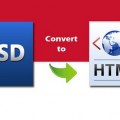HTML5: Here to Stay
If you haven’t started using the new HTML5, you have been missing out. Although it is true that, as a new program, HTML5 has yet to be accepted across all platforms and for all programs, there is little doubt that it will be sooner or later, it will be essential for websites. You should concentrate on becoming familiar with this type of web design coding if you plan on working in the fields of web design, graphic design, online development, and computer science.
In many ways, it is the most powerful yet simple coding language available on the market today. So in general, what separates the HTML5 coding language from its competitors and makes it a surefire tool of future web design?
Accessibility
With the HTML5 coding language, creating accessible web pages is easier than ever thanks to its semantics and ARIA, a support tool for web apps that are designed by developers. Web developers rely on ARIA and HTML5 for additional information and for elements such as screen readers. New HTML headings allow screen readers to easily access content, unlike before when most screen readers had trouble identifying the
<div>
coding. HTML5’s new semantic coding makes sites easier to read and improves the experience of users. ARIA is a W3C spec that assigns roles to elements in HTML documents, creating user tools like the header, footer, and navigation buttons. The updated version of HTML validates these aspects and makes them more user-friendly.
Doctype: Document Type Declaration
HTML5 cleans up the complicated code that has been traditionally associated with HTML coding, getting rid of the long and tedious codes normally needed to program most aspects of a webpage and replacing them with much shorter and logical codes known as doctype. HTML 4.0 requires three different types of
<!DOCTYPE>
declarations, but HTML 5 only requires the singular
<!DOCTYPE html>
to be coded properly. This can affect many programming aspects of the website, including video and audio links which used to be terribly difficult to imbed into websites. However, with doctype technology, you essentially type out your demands and voila!, they function the first time you try it out!
Storage
Most websites use cookies to store user information and make browsing more personalized. However, cookies can actually cause a developer to experience a series of potential problems, and this type of storage system is not often always transferable across certain devices. The new HTML5 uses a new local storage feature similar to cloud technology to combine elements of cookies with client-side storage to basically save client data within the client’s own web browser, allowing for storage across windows and even after a browser has been closed. Cookies are limited to only about 4 KB of data which can easily slow down the application as well. HTML5 offers a lot more storage space and what is even better is that with the additional storage space, this makes web apps available without using third party plugins that often slow down the computer and can contain viruses or other malware. Overall, it really is a win-win situation.
Dynamic Interactions
Most web designers love tweaking their websites so that they have the most intuitive yet entertaining series of webpages possible compared to other designs. With HTML5’s new APIs or Application Programming Interfaces, users can craft their websites with an ease that was impossible before the coding language was being used by web designers. Some of the new APIs that are integrated into the HTML5 coding include: Drag and Drop (DnD), offline storage database, browser history management, document editing, and time media playback.
Media API uses two essential elements from the HTML5 coding language: video and audio elements. Different JavaScript methods such as
play (), pause (), load () and canPlayType ()
are properties used to create different audio and video. Along with Media API, Text rack API is used to create subtitles in order to label different audio and video elements.
HTML5 is also able to take API to a whole other level by allowing developers to view more in a user’s browser history. With HTML5, you can add and remove search entries and website history from the database, use data to restore a page, and even updated the URL without fully refreshing the website’s page.
Compatibility
HTML5 is compatible across all of the most popular browsers, including Firefox, Chrome, Safari, and Opera, and is even usable in older versions of our favorite browsers. Relatedly, HTML5 is the most mobile-friendly coding available on the market today, taking over where Flash has left off in coding development. HTML5 has even incorporated specific elements to make mobile web design as easy as possible, including Meta tags allowing you to play with the viewing and zoom displays and add home screen icons. Building a website or updating a current site has never been easier!
With HTML 5, developers can update an app or website without any type of approval. This is another great advantage of using HTML5 because any bugs that are affecting app users and website visitors can be fixed just like that!
HTML5 brings together the best elements of the old HTML and other coding versions to give users the easiest and most feature-packed web design experience possible. It is one of the most accepted coding languages available cross-platform and has made its commands some of the most straightforward and logical available on the market today. We should see the HTML5 coding language continue to dominate the World Wide Web as we know it. More apps and website interfaces are being created by developers, especially with smartphone technology development. App building itself was a huge part of the technology growth sector for 2013 along with Smart TV and Google Glass. There is no reason to build an app or website with OS/Android language when HTML5 is so simple and much more efficient. If you haven’t started taking advantage of its many benefits, now is the time.
Tags: html5, web design resources, web development resources










































